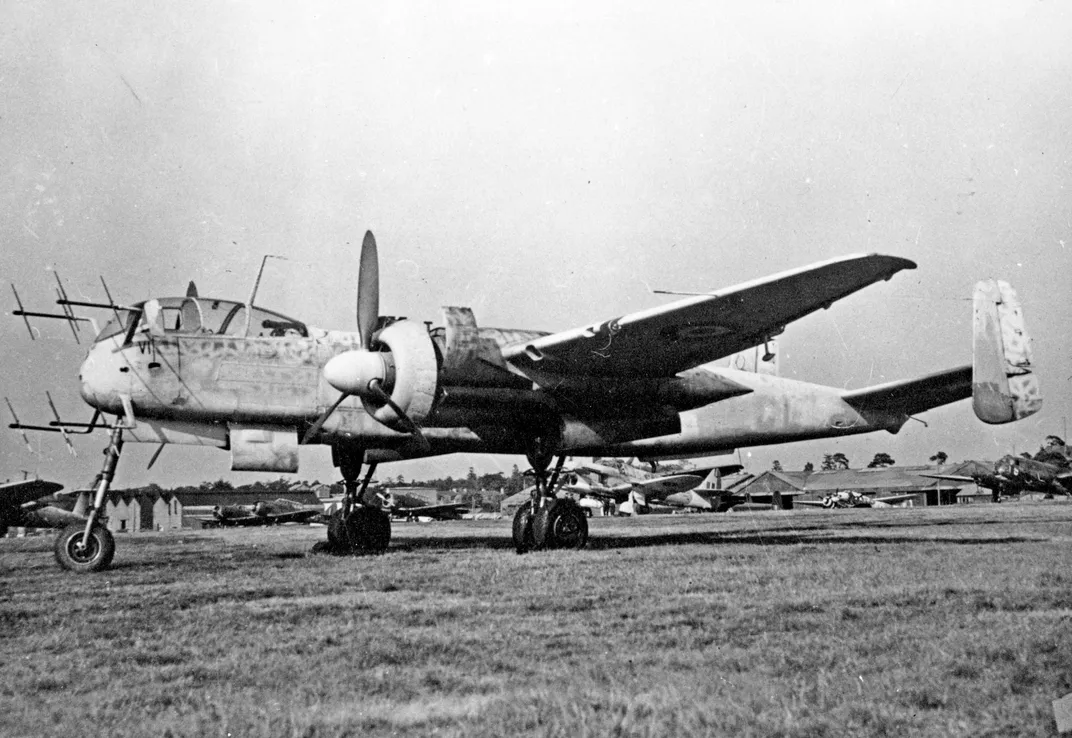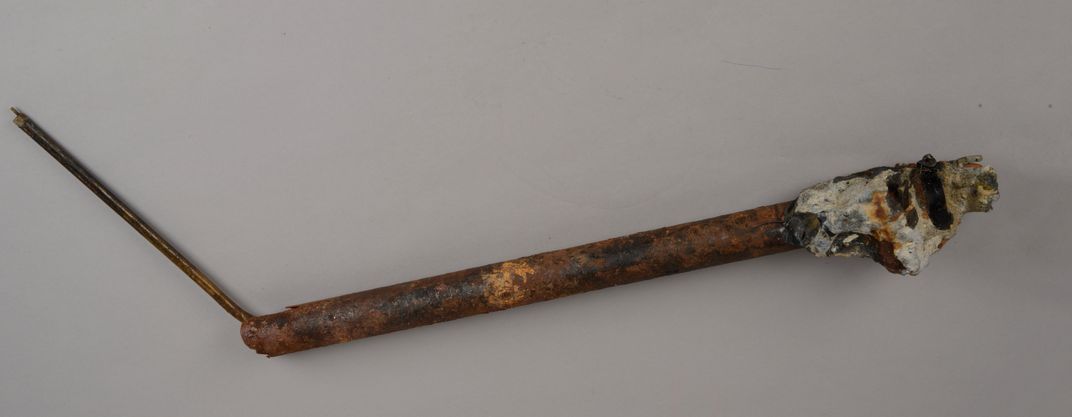A Feared Nazi Night Fighter Is Being Restored 70 Years Later
The Heinkel He 219 will soon have its nose-mounted radar back.
/https://tf-cmsv2-smithsonianmag-media.s3.amazonaws.com/filer/3f/86/3f86c284-12d1-4422-a34c-6be019c1e06f/16j_aug2018_p1100661_live.jpg)
In 2012, Danish divers pulled the badly corroded wreckage of a Heinkel He 219 from the waters off the Jutland peninsula, where it had been submerged since World War II. It was a remarkable find: No more than 294 of the night fighters were built for the Luftwaffe, and before this discovery, there was only one known survivor, which is in the collection of the Smithsonian National Air and Space Museum. The Museum’s He 219 was one of dozens of enemy aircraft presented to the United States after World War II by U.S. Army Air Forces commander Henry “Hap” Arnold.
In 1945, three He 219s—along with other captured German aircraft—were shipped from Europe to the United States aboard the HMS Reaper and then flown to Freeman Army Airfield in Indiana for testing.
The Museum’s He 219 arrived at what was then the Smithsonian’s National Air Museum in early 1949. It was reasonably intact but lacked one important item: its nose-mounted intercept radar.
The radar made the He 219 a successful night predator. Once the aircraft intercepted a foe—by homing in on radar emissions resulting from security lapses, for instance—it fired one of its 30mm cannon, installed at such an oblique angle that the 219 could fire from behind and below a bomber, attacking its vulnerable underside. A heavy bomber could be dispatched with just three rounds.
While early versions of the aerial intercept radar installed on the He 219 could be blinded by chaff, later versions were immune. The combination of aircraft and radar proved so formidable that, by early 1944, Royal Air Force bomber losses were as high as 12 percent on some raids.

**********
In photographs of the three He 219s at Freeman Army Airfield, all of the aircraft have their antenna arrays. It’s not clear why or when the radar arrays were removed, but the missing antenna masts posed a problem for the restoration specialists at the Museum. When they began restoring the He 219 a decade ago, they weren’t sure how to fabricate the missing masts.
“We had a lot of pictures,” says project lead David Wilson, “but none of them were very good. We couldn’t come to an agreement on exactly how the antenna masts were made.” (While the antennas themselves are universal, the masts that attach the antennas to the airframe are not; they are built specifically for each aircraft type.)
“The masts are curious,” says Rob Mawhinney, a specialist in the Museum’s restoration shop. “There’s no documentation on who built them. They’re not in the spare parts handbook for the Heinkel 219, and they’re not in the spare parts book for the radars, because they are unique to each airplane. There had to be teams that specialized in making the masts for different airplanes. But none of that information has surfaced.”
The shop contacted various archives hoping to find more information; Mawhinney even went to Germany hoping to find something about the masts in Ernst Heinkel’s papers but came up blank. “I was starting to give up,” he says. “Then we heard about the Danish wreck.”
“When I saw the photographs of the wreckage,” says Mawhinney, “I was seeing blue wire everywhere. That’s radio cable. Somewhere at the end of that cable had to be a piece of radar mast.”
The wreckage, originally examined by the Aalborg Defence and Garrison Museum, was subsequently purchased by a museum whose owner wishes not to reveal its identity. Last year, the new owners of the 219 wreckage agreed to loan the radar array to the Museum’s restoration shop. “It was like Christmas morning when we unpacked the loaner masts,” says Mawhinney.

But there was still a problem: The masts, which had been underwater for nearly 70 years, were covered in coral deposits, and the electrical junction was obscured. The shop X-rayed the masts but needed more information than the X-rays could provide.
They obtained permission from the loaning museum to remove the coral in order to see how the mast was constructed and wired. “After getting nowhere trying mechanical methods of removing the coral,” says chief conservator Malcolm Collum, “I ended up using a mild acid solution and ran an electric fish tank pump to keep a constant flow of the solution over the coral.” Several weeks later, enough detail was exposed that the team could reverse-engineer a replica antenna.
“Then we reached another stopping point,” says Wilson. “We didn’t have the mast attach points. What they sent us didn’t have the piece that attaches the mast to the airframe. But Rob took some detailed pictures of our aircraft, of where they should be.” These photos were sent to the owners of the Denmark wreck, with the request to look at the airframe in a specific location, and, sure enough, the attach points were there. Using a 3D scan provided by the loaning museum, the National Air and Space Museum was able to print a mold of the attach points.
The restoration has revealed other information: “Every component—each vertical, the horizontal itself, the rudder, each aileron—has a serial number tag that indicates the factory where it was manufactured,” says Wilson. “And we discovered that every component was made at a different location and then sent to the main factory and put together.”
The unassembled He 219 is currently on display at the Museum’s Steven F. Udvar-Hazy Center. If all goes well, in about a year the aircraft will be put back together. “It’s one that the whole shop would like to finish,” says Gary Gordon, one of the Museum’s restoration specialists. “Even volunteers who are retired want to come back and work on this.”
When it’s complete, one of the most feared fighters of World War II will again have the component essential to its reputation.
